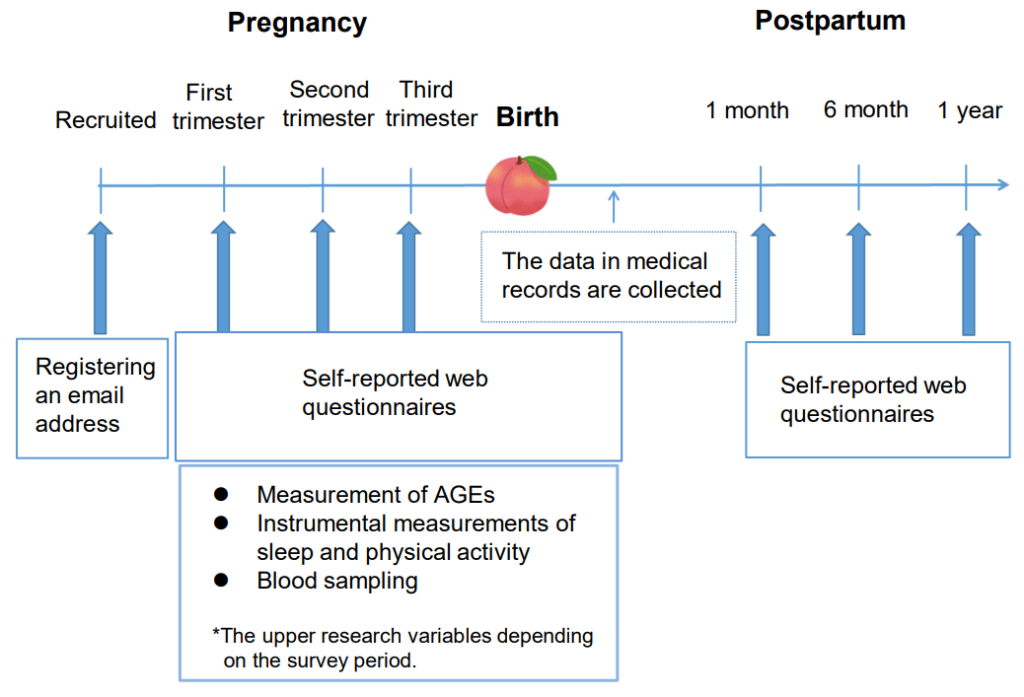About J-PEACH Study
Overview
We are conducting a comprehensive nationwide survey to explore the lifestyle and health of pregnant women and postpartum
mothers across Japan. This study examines various lifestyle factors, including symptoms like morning sickness, perceptions of
weight control, eating habits, dietary history, employment status, mental health, sleep, and physical activity both during
pregnancy and after childbirth.
Objectives
Our primary goal is to uncover the maternal lifestyle patterns and health statuses during pregnancy and postpartum and identify
key factors influencing them. The findings from this survey will enhance health guidance for pregnant women and contribute to
developing appropriate weight gain recommendations for pregnancy.
Participants
Pregnant women are eligible to participate in this study if they are:
- Of 18 years or older and proficient in reading and writing Japanese.
- Expecting to deliver at a participating birthing facility in Yamagata, Tokyo, Osaka, or Fukuoka Prefecture.
Research contents
Our study uses four main methods for collecting participants’ data;
1. Web Questionnaires
Participants will be asked to self-report on various data such as morning sickness, diet, weight, physical activity, sleep, employment, mental health, maternal and infant health status, and breastfeeding methods. These questionnaires can be accessed and completed using either a computer or smartphone.
2. Blood Sampling (only in the Tokyo region)
Blood samples will be collected during routine pregnancy checkups conducted by the birthing facility, which involve blood draws.
3. Instrumental Measurements of Sleep and Physical Activity
Participants will wear an accelerometer on their arm to measure sleep (Axivity AX3, ACCELStars) and on their waist to measure
physical activity (Active Style Pro HJA 750 C, Omron) for one week.
4. Measurement of Advanced Glycation End Products (AGEs) (only in the Tokyo region)
We will use the AGE Reader device (AGEs Reader Device, DiagnOptics BV Groningen) to measure AGEs in the skin. AGE Reader is
a non-invasive monitoring device that uses ultraviolet light to excite autofluorescence in human skin tissue. The device provides
results in a few seconds when placed on the skin.
The flow of Research
The study is divided into six survey periods: during the first, second, and third trimesters of pregnancy and at one month,
six months, and one year postpartum.
Besides, the questionnaires and instrumental measurements, we will also collect health-related data for the mother and baby from
the medical records of the birthing facility throughout the study period.
By participating in this research, you will contribute with your valuable insights to improve maternal and newborn health
nationwide. Thank you for considering our study.

Research achievemens
- Nao Nishihara, Megumi Haruna, Yuriko Usui, Kaori Yonezawa, Naoko Hikita, Emi Sasagawa, Keiko Nakano, Moeko Tanaka, Riko Ohori, Satoko Aoyama, Satoshi Sasaki, Megumi Fujita, Masayo Matsuzaki, Yoshiko Suetsugu, Yoko Sato (2023). Dietary Intake and Its Association with Birth Outcomes in Women with Nausea and Vomiting during the Second Trimester of Pregnancy: A Prospective Cohort Study in Japan. Nutrients, 15(15):3383. https://doi.org/10.3390/nu15153383
- Ai Shibata, Megumi Fujita, Sanae Yamaguchi, Momoka Yoshimura, Akiko Murakami-Sekimata, Masayuki Sekimata, Megumi Haruna (2023). Association of salivary Porphyromonas gingivalis with frequency ofmeals,smoking history and oral care in pregnant women: a cross-sectional study. Journal of Nursing Science and Engineering, 10, 211-220. https://doi.org/10.24462/jnse.10.0_211
- Momoka Yoshimura, Megumi Fujita, Ai Shibata, Riko Ohori, Satoko Aoyama, Kaori Yonezawa, Yoko Sato, Satoshi Sasaki, Masayo Matsuzaki, Yoshiko Suetsugu, Megumi Haruna (2023). Association of Eicosapentaenoic and Docosahexaenoic Acids Intake with Low Birth Weight in the Second Trimester: The Japan Pregnancy Eating and Activity Cohort Study Nutrients, 15(22):4831. https://doi.org/10.3390/nu15224831
- Megumi Fujita, Ai Shibata, Akiko Sekimata, Megumi Haruna (2022). J-PEACH Study during the COVID-19 Pandemic at Yamagata University. DOHaD research, 10(1), 49-52. https://doi.org/10.51067/dohad.10.1_49 (in Japanese).
- Ai Shibata, Megumi, Fujita, Sanae Yamaguchi, Momoka Yoshimura (2022). Oral hygiene behavior and subjective periodontal disease symptoms of pregnant women in the second trimester during the COVID-19 pandemic. J. Jpn. Acad. Midwif, 36(1), 129-136. https://doi.org/10.3418/jjam.JJAM-2021-0032 (in Japanese).
Research member
Chief Research Institutions
- Professor Megumi Haruna, Lecturer Kaori Yonezawa, and Assistant Professor Yuriko Usui at Department of Midwifery and
Women’s Health, Division of Health Sciences & Nursing, Graduate Schoolof Medicine, The University of Tokyo
https://midwifery.m.u-tokyo.ac.jp/ - Visiting Researcher Masayo Matsuzaki at Department of Midwifery and Women’s Health, Division of Health Sciences &
Nursing, Graduate Schoolof Medicine, The University of Tokyo and Department of Reproductive Health Nursing, Graduate School of Health Care Sciences, Tokyo Medical and Dental University - Professor emeritus Satoshi Sasaki at Department of Social and Preventive Epidemiology, School of Public Health,
Graduate School of Medicine, The University of Tokyo
Collaborating Research Institutions
- Professor Megumi Fujita at Department of Clinical Nursing, Graduate School of Medical Science, Yamagata University
https://yume-n.jp/gradschool - Professor Mie Shiraisi at Department of Children’s and Women’s Health, Division of Health Sciences, Graduate School of
Medicine, Osaka University
https://sahswww.med.osaka-u.ac.jp/jpn/departments/ - Professor Naoko Hikita, Lecturer Mikiko Sueji, and Assistant Professor Yoko Sato at Department of Health Sciences,
Graduate School of Medical Sciences, Kyushu University
https://www.shs.med.kyushu-u.ac.jp/
